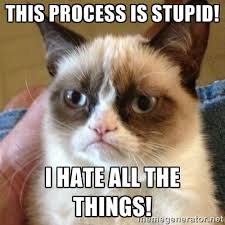
The image above shows all the classic things we’ve learned to do before an important meeting or interview.
- Dress appropriately. Not only does that mean not “under dressing,” but it also means not “over dressing!” Do your research and then dress one level up.
- Arrive in good time. Well, duh.
- Body language. Be aware! Assume an open and interested position (arms resting in your lap or on the arms of your chair), don’t check your watch or (heaven forbid) your phone, and above all else, don’t interrupt!
- Expect the unexpected. Yup. What if you’re kept waiting 30 minutes? What if you have to do a presentation on the spot? What if it’s super hot in the interview room? Plan to keep your cool in all situations.
- Ask questions. For sure. And don’t ask “when will you make your decision,” as if you already have the job. A great one is “what will the most challenging thing be for the successful applicant?”
But those are the standard things. The things you can learn if you google “interview prep” or ask your friend how they got their job.
Secrets to Crushing Any Interview
- Use “I” not “we.” Yes, that’s right. Talk about yourself. As someone who has interviewed hundreds of people, I can tell you that when you are asked to “tell me about a time when you led a complicated project with a diverse team,” then I want to know what YOU did specifically. Not what your whole team did. Now is not the time to “share the credit.” For example:
- Bad answer: I was the project lead for Project X, and we worked together to create SMART goals, communicate effectively, and follow project management principles.
- Good answer: I was the project lead for Project X, and early on I established the team guidelines. I facilitated the team agreement on goals, coordinated and moderated regular updates, and developed job shadowing practices so that people could fill in for each other during crunch times.
- Use action words. In the example above the words “established,” “facilitated,” “coordinated,” “moderated,” and “developed” are all action words. Example: “Tell me about the work you did in your most favourite job?”
- Bad answer: I loved my job two years ago because I was responsible for team engagement and new employee onboarding and it was very rewarding.
- Good answer: I loved my job two years ago because I championed team engagement by leading quarterly brainstorming sessions, developing and implementing engagement programs like Job Shadowing for new employees, and facilitating bi-annual engagement feedback sessions with the VP. It was really rewarding to see engagement scores increase and to get positive feedback from the team.
- Tell stories. Many interviewers will start a question with “describe a time when you…” Others will start with, “have you ever…” And still others will say things like, “what’s your greatest or worst skill?” Each of these is a chance to tell a story. It will be tempting to answer quickly, but what you want to do is answer in a way they will visualize and remember. Example: “OK, you’ve been telling me about all these things that you do so well, but we all have weaknesses or opportunities to improve. What’s one of yours?
- Bad answer: I actually don’t have any weaknesses because I have been honing my skills for years. (I’m not kidding. That’s a real answer I got once.)
- Alternate bad answer: A weakness? Oh. Well, I guess I can get flustered some times when timelines shift quickly, but I am really good at re-configuring my plans so everything comes out ok.
- Good answer: On a recent project the timelines shifted a few times, as they often do on large projects. By the third time shift I realized that I should be using a different milestone chart that is more adaptable when there are changes. By implementing that, I was able to reduce the frustration I can feel if things shift too frequently.
These three tips will help you stand out (in a good way) and increase your likelihood of winning the competition. Have you used any of these before? Let us know on Twitter (@whiteboardcons) using #InterviewPrep!
Until next time,
Ruth.
PS – did you know we offer coaching for interview prep? It’s true. Click here and read all about it.
















 awkward asking these questions. I guarantee that this moment of mild awkwardness is FAR less painful than arriving at TWCC (Toxic Workplace Culture Central). Read more on the signs of a toxic workplace culture
awkward asking these questions. I guarantee that this moment of mild awkwardness is FAR less painful than arriving at TWCC (Toxic Workplace Culture Central). Read more on the signs of a toxic workplace culture 




